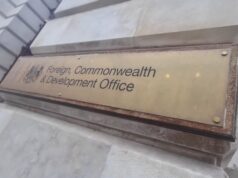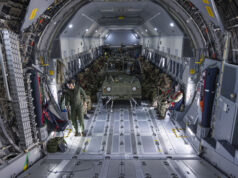The Ministry of Defence (MOD) has announced plans for a Tactical Communications Logistics Support (TCLS) contract, valued at up to £550 million, to sustain the UK’s battlefield communications systems.
According to a prior information notice published on 3 September 2025, the five-year contract will run from February 2028 to February 2033 and will provide spares, repair support, stock management and storage for tactical command, control and communications equipment.
The MOD said the service provider will be responsible for monitoring demand through forecasts, managing repairs, and recommending future spare purchases for approval. The requirement is linked to the Land Equipment Tactical Communications Information Systems (TacCIS) programme.
To shape the requirement, the TacSys Service Executive Team will host a supplier conference on 16 October 2025 via Microsoft Teams. The event will run from 1000 to 1230 hrs and will be recorded, with copies available afterwards through the TacSys Service Executive Industry Engagement channel.
The MOD stated the purpose of the conference is to update the market, explore key challenges and opportunities, and better understand industry capabilities. It follows a previous TacSys industry day held in January 2025.
The MOD said that the engagement does not constitute a pre-qualification exercise. Any formal procurement process will be conducted in accordance with procurement law.














Is “looking at” the same as pre-concept studies?
*asking for a friend
It seems that professional, traded soldiers cannot look after their own kit anymore. I suppose that it saves on pensions.
Tell me you don’t understand what software radio is without saying what software radio is. How do you think encrypted data links work?. Just how many traded soldiers have the knowledge to write secure code that encrypted data and protects the network from hacking?
Five Hundred And Fifty Million Pounds Sterling! Just say that out slowly.
How about the RN looking after their own kit and spending the £550m on another T31.
This is where much of MoD budget goes to.
And to be fair, DE&S, Defence Equipment and Support, is not just about buying equipment, perish the thought.
Another contractor within the MIC smiling.
Shown again and again by Ministers own statements where their priorities lie.
The prices always seem inflated, don’t they. But that is the whole point, profit at MoD and tax payers expense.
Assume back in Cold War days this was in house?
I’m old enough to remember the Cold War, and I don’t recall anything like this happening. I’m guessing it’s an extension of Gordon Brown’s crazy PFI schemes. You know, “It’s the Navy’s job to inflict lethal force on our enemies, not own and maintain the things we use to do so – someone else can do that better than us.” Better maybe, but at a much greater cost because of all the risk and reward stuff, and the fact that Brown and his civil servants were economically illiterate (an economically illiterate Chancellor, now where have I heard that said again recently!) and had no commercial experience. So they got rinsed.
Seems as if it’s still happening.
Well I’m 53, so so am I, the latter part of it at least.
“……update the market, explore key challenges and opportunities, and better understand industry capabilities. ….’
Few more for the MOD bingo card there !!
A good description, PC.
The plain English campaign could visit? Plenty of material to be had amongst the spin, half truths, and deflection.
Nah back in the cold war days this probably didn’t exist.
What they are talking about is computer communications – like a network (or internet if you like) except it must obviously be fast, secure and highly difficult (if not impossible) to jam. Obviously they will want it designed from the ground up in the UK. Not a trivial piece of work. Personally I suspect they will be lucky to achieve this for the price of £550M.
Hi Mark.
Yes, another Army CIS assst. I was wondering if maintaining it in house, like at the current DECA, would be cheaper than outsourcing.
As others have noted, not every soldier will have the skill or the time unless maybe REME.
LETacCIS is Army only, with projects like Trinity, Morpheus, Bowman and DSA. If this is linked, I’d assume it’s nothing to do with the Navy. As well as supporting new equipment, with Morpheus going quiet, I’d imagine it also has to do with extending and supporting Bowman for a number of years until a transition can be made to something better.
Hi Daniele, To talk just Army as this is for LandTacCIS…Back in the day and not even going back as far as the Cold War, spares fitted by the User or REME were procured by Civil Servants (CS) in the relevant IPT for Level 1, 2, 3 Maint. User would do Level 1 maint, REME attached to the unit (First Line ie LAD/Regt Wksp) would do Level 2 maint, REME at REME Battalion (Second Line) or pers at REME/ABRO/DSG Static workshop in UK or Germany would do Level 3 maint and Industry would do Level 4 maint.
Army would store equipment, never Industry.
Under this new contract the service provider (Industry) will be ‘responsible for monitoring demand through forecasts, managing repairs, and recommending future spare purchases for approval’. All used to be done in-house by the IPT (formerly at Andover (HQ QMG then DLO) but latterly at the IPT at DE&S ABW. All that, plus spares management/ordering, stock management and storage was or is done in-house by the IPT.
There is little competitive about this new process. A bidder that could do this for £350m expended will bill MoD for £550m. The MoD should simply set equipment availability criteria and challenge Industry to bid for the service and state their price. Lowest price proposed by a credible bidder wins.
What is not clear is how much uniformed personnel will be allowed to still do in the way of maintenance.
Why would they get uniformed staff to do the maintenance when they can have a contract with private sector organisation creaming off profit with each intervention. Anything to reduce HMG headcount’s …because private profit from taxpayer is good but public sector workers are bad…
It would be hard for soldiers to maintain their own kit. For example, ATAK or DSA, is like a smart phone for dismounted infantry, chest mounted, working on an encypted, distributed mesh network. How many people here can maintain an ordinary Android phone, beyond pressing a button to get updates? What if you had one bolted down that you weren’t allowed to get root access to? Still confident? What about diagnosing faults with the local network? Can you do more than switch a router off and on again?
It’s true that fixing things sent back when they’ve gone wrong can be handled by military personnel or industry. Perhaps it’s a reasonable decision not to pay for an IT engineer in uniform, when broken devices are unlikely to be repaired at the front, and instead just keep a number of spares. On the other hand there’s a sovereignty argument that says Army logistics are too important to be left to industry. In today’s politics it’s clear which argument holds sway.
It will be interesting if the new Digital Warfighter Group mentioned in the SDR, who are expected to program and arrange fast turn around of software at the front, will inspire a harware parallel in the days of drone updates every two weeks. Perhaps comms and networking will follow.
Evening Graham.
Thank you for that, much as I recall re ABRO / DSG.
For clarity and detail on acronyms, as I get ticked off myself for using too many, and a bit of background on the support side.
ABRO Army Base Repair Organisation. The “in house” Army support organisation we had back in 90s which I had in mind and would like to see again. Was “replaced” by DSG.
DSG. Defence Support Group, “replaced” ABRO, after bulk of that was sold off, before the DSG itself got chopped. DSG also took parts of DARA, Defence Aviation Repair Agency.
Interestingly, a part remains in house at MoD, the avionics side was sensibly retained as DECA, Defence Electronics and Components Agency, at the olf RAF Sealand, and is now DE&S DECA.
Through the decades, when HMG had had their fill of cutting the front line, the support orgs are often next. DERA was another ridiculous example.
LAD, Light Aid Detachment, small number of REME personnel attached to a unit.
Wksp. REME Workshop, a larger REME complement attached to Regiments with kit holdings needing greater support levels, such as 28 RE.
( Which Graham served in. )
IPT. Integrated Project Team, the procurement teams at DE&S ( and previously at DPA ) that buy kit for the forces once the requirement has been decided and approved at MoD. “Pen Pushers” as they are often erroneously and unfairly called here, and can be a mix of both civilian and military personnel.
DPA Defence Procurement Agency. Became DE&S by merging with the DLO, was once the PE Procurement Executive in the Cold War.
DLO. Defence Logistics Organisation.
Andover QMG Quarter Master General, a senior logistics post in the Army, who headed the in house Army logistics organisation of the same name, and who usually sits on the Army Board. Was merged into DLO as the 3 single service logistics commands got chopped in the late 90s early 2000s.
ABW, Abbey Wood, location of the bulk of DE&S.
DM, DM, I hope you don’t think I’m ticking you off!
It’s just nice to be able to read things and understand them, that’s all!
You should try listening to ATC cadets describing the various staff in their squadrons, it’s a nightmare.
Evening mate. No worries, I know I go OTT with the acronyms so thought as it wasn’t me I’d be helpful for a change.
Right then, I got a complaint DM.
Every time you go off on one with your acronyms, it takes me ages on Google to understand just WTF It all means !
At least I’m keeping you engaged and interested! 😉
True, I need some distractions ! It’s New bike day today, I’m like a kid at christmas waiting for it to turn up !🏍️
Hi Graham, not quite correct, I am ex Royal Signals, we would do much of the work ourselves. We hated it when our kit had to go to REME because they would keep seending it back to manufacture spec. However what worked in the workshop did not always work in the field. Especialy our secu8re comms, we always had issues with our earthing. Don’t get me started on the old KW7s or red green audio, the moment it went into REME and back in the field I would spend two or three days fixing it.
By the way people I have a simple question that I cannot find an answer for, training. When I reported for duty I was 16 years and one day old. I went to the Army Aprrenticies college Harrogat and spent a few years learning my trade. REME, Engineers and I think Artillery also had trade colleges. Now that these colleges are closed where do the young tradesmen get the same level of training.
Well the AFC is still at Harrogate, assume younger volunteers get that there?
Otherwise, during Phase 2 of training after attending Army Training Regiment for basic, or Phase 1, and in the case of the Infantry at ITC Catterick.
The RSS, Royal School of Signals is still at Blandford, alongside 11 Signals Regiment.
I think RS went through Pirbright or Winchester first, don’t recall.
Also, there was the Defence Sixth Form College Welbeck, which was at Garrats Hay till recently, next door to the old Y services RS location.
They did training for technical Corps I believe.
Closed now, don’t recall where the capability went, unless lumped into phase 2 as suggested.
Interestingly, the purpose built site is I understand still empty, but remains a StratCom site and currently houses Afgans!
Oh goody, Clansman on speed. Preferred Larkspur as the crackles were more crackly.